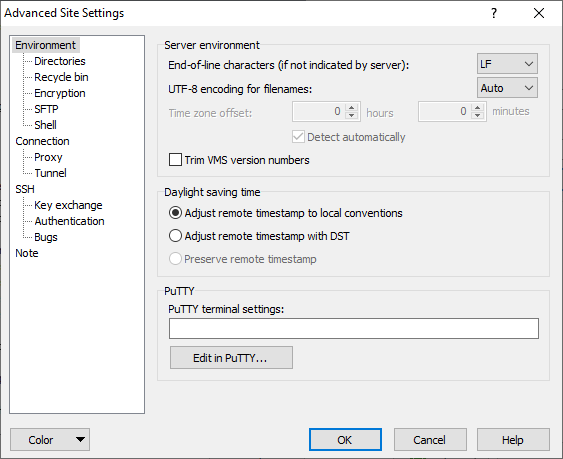This is an old revision of the document!
Environment Page (Advanced Site Settings dialog)
The Environment page on the Advanced Site Settings dialog allows user to configure WinSCP adaptation for particular server/environment.
_login_page
Advertisement
More environmental options are available on subpages:
- Directories (initial directories, directory cache)
- Recycle Bin
- SFTP (SFTP protocol specific/compatibility options)
- SCP/Shell (shell and SCP protocol specific/compatibility options)
- FTP (FTP protocol specific options)
Refer to documentation of page sections:
Server Environment
End-of-line Characters
Use End-of-line characters to specify text file format used by the server. To allow text mode transfers, WinSCP needs to know the format of text files. Generally there is plenty of text file formats, almost every platform has it own format. WinSCP supports two most used formats, Unix and Windows. As most servers are run on Unix system, generally you may leave the default Unix format. If your server runs on Windows, select the Windows format. If you do not use text mode transfers, the option is not important for you.
Advertisement
With SFTP-4 and newer, the server tells itself what format it uses, so the configured option is not used.
With FTP, the option is disabled, as protocol specification defines the text file format. With WebDAV, the option is disabled as the protocol does not support text mode transfers.
UTF-8 Encoding for Filenames
Use UTF-8 encoding for filenames to configure if WinSCP should use UTF-8 (Unicode) encoding for filenames in communication with the server.
With default Auto value, WinSCP will try to autodetect if the server supports UTF-8. With SFTP protocol this means that UTF-8 is used for protocol version 4 and newer; for older versions, UTF-8 is used unless the server is known not to support UTF-81 or it sends strings not encoded with UTF-8. With FTP protocol this means that UTF-8 will be used when the server announces support for it. With SCP protocol this means that UTF-8 will be used when a LANG environment variable is set to “UTF-8” encoding.
Set the option to On to force usage of UTF-8 (useful for servers using UTF-8 natively). Set the option to Off to unconditionally disable usage of UTF-8 (for SFTP servers that does not use UTF-8).
With WebDAV, the option is disabled as UTF-8 is always used with the protocol.
Timezone Offset
The Timezone offset allows user to configure timezone difference of the server.
With SCP protocol the option is used to counterweight time difference between timestamp of remote file shown in directory listing and timestamp set on downloaded file, and vice versa. The difference is caused by fact that during transfer scp command usually uses UTC time format, while ls command may display time in local (for server) time format. The time difference can be negative. For example if the timestamps of remote files are two hours ahead of local files, set the option to -2 hours. Read about other issues with timestamps.
With FTP protocol the option is used to actually set the difference between local and remote timezone. Though it is used, when deprecated LIST command is used for directory listing, only. When using MLSD, the server must report all timestamps in UTC. To enable the option with FTP protocol, you need to opt to use LIST command explicitly by setting Use MLSD command for directory listing to Off. Though, you should use this only when the server does not support MLSD command or its implementation is buggy. The difference is automatically detected.2 If the detections fails, uncheck Detect automatically and set the difference manually.
The option is not available with SFTP and WebDAV protocols, as with them, the server must report all timestamps in UTC.
Daylight Saving Time
Some servers (mostly servers running on the older versions of Windows) incorrectly adjust file timestamp with start of DST. The Daylight saving time option allows you to counterweight the incorrect behavior. The option is not available with FTP protocol,
Select Adjust remote timestamp to local conventions, if the server behaves correctly and does not adjust file timestamp (typically Unix-based servers and Windows 7 and newer).
Select Adjust remote timestamp with DST, if the server does not behave correctly and adjusts file timestamp (Windows Vista/2008 and older).
Advertisement
Change the option, if timestamps of some files in the remote panel are shifted by one hour. This can happen either for already existing remote files, or for newly transferred files. For the latter case, please note that the option must be set correctly before transferring the files. It does not make sense to try to use it to adjust the incorrect timestamps of already transferred files.
Use the third option Preserve remote timestamp, if you want to see exact non-adjusted remote timestamp in remote panel. Drawback is that with the option selected, the synchronization functions will not work. This option is not available on Windows 7/2008 R2 and newer.
Read about other issues with timestamps.
The option is not available with WebDAV protocol, as with it, no issues are known that would require it.
Further Reading
Read more about Login dialog and Advanced Site Settings dialog.
